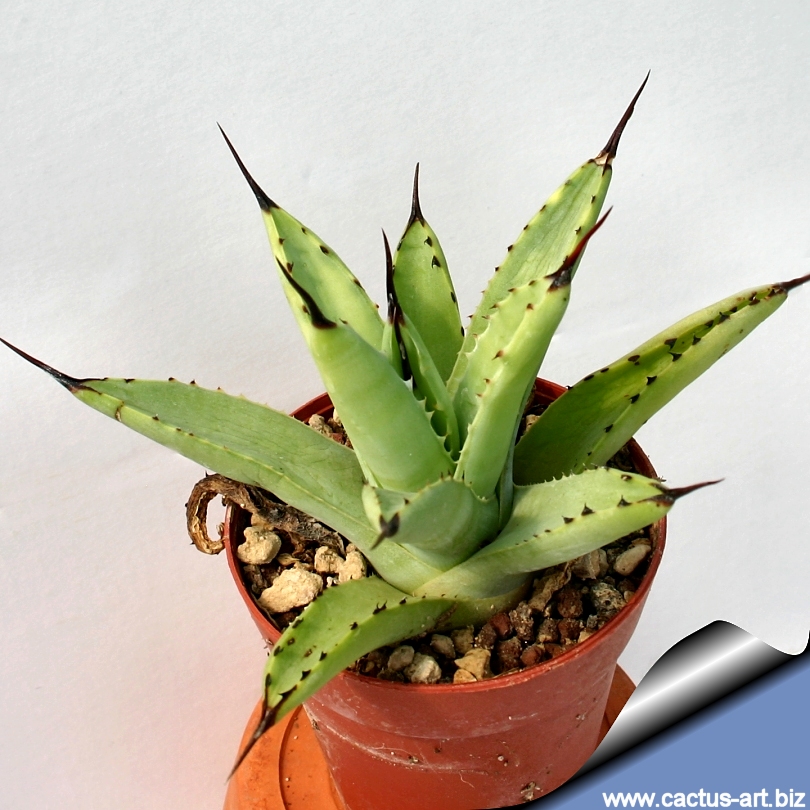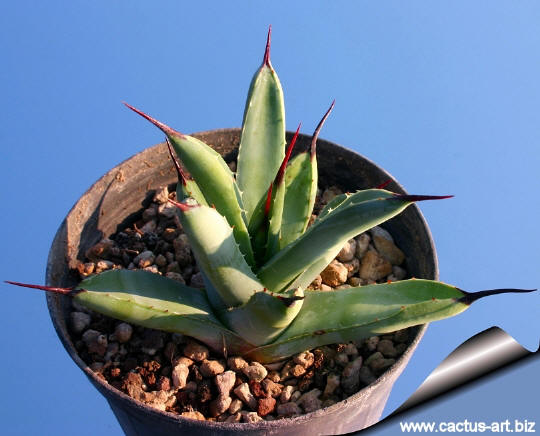|
|
|

Agave macroacantha "viridis" (A juvenile specimen)
This small and elegant, spherical clumping agave forms, 30 cm
rosettes composed of, stunning narrow leaves tipped with an impressive
black-brown spine. The so called forma "viridis" has paleer glaucous
/yellowish/green leaves (while the standard form has powdery blue
leaves)
|
|
Description: This
is a very distinctive small to medium-sized stemless or short-stemmed
Agave, it forms, neat, compact, rosette composed of many narrow leaves.
In the wild it is a very variable plant, with some populations having
large, jet-black terminal spines, some having red-brown spines, some
with small spines, some large. It forms dense clumps apparently
generated by the multiplication of ground-level offshoots to nearly 60
cm tall by 150 cm wide comprised of 25 to 35 inch wide rosettes.
Leaves: Grey-blue, straight, dagger-like, evenly spaced that
radiate straight out from the center of the plant, up to 55 cm long (but
usually not more than 15-30 cm) with a thick, stiff, prominent, stright
or ondulate, rounded below, 3 cm long terminal spine (white/brown) dark
brownish-red to almost black) . The margins of the leaves are very
straight (or some time undulate) and have short, contrasting dark brown,
serrated teeth 0,5-2,5 cm apart. .
Flowers: The inflorescence is made up of a 2 metre slender stem
with 10 to 14 lateral branches which hold groups of purple-tinged green
flowers with a fuzzy interior flowers. Often after the flowering there
appear “ small bulbs”( already formed tiny plants) which fall to the
ground, giving life to a new colony of Agaves. When this plant begins to
flower the center leaves take on an attractive reddish hue from where
the dark red inflorescence begins to emerge
Blooming season: Spring to summer. The species does not flower as
freely as some, the plant needs to be 15 years or better to flower.
Use: These striking plants are
wonderful when used for accent or simply to provide some all year round
foliage colour and often used in a pot as a patio plant, they make an
eye-catching statement and along with other evergreen plants in pots,
can be moved around to change the scenery or position to give more
shelter.
|
|

 |
|
Advertising
|
|
|
|
|
Family: Agavaceae
Accepted
Scientific Name:
Agave macroacantha
Zucc.
In: Flora 15:297, 1832
Common (Mexican) Names include:
Black-spined Agave
Origin: Mexico ( Oaxaca and
near Tehuacan in Puebla)
Habitat: Grows
in barren rocky and very arid terrain where it grew with Cephalocereus
hoppenstedtii, Neobuxbaumia tetetzo and a Mammillaria sp. at 1500-2000
m.
Synonyms:
- Agave flavescens var. macroacantha
(Zuccarini) Jacobi 1864
- Agave flavescens var. macroacantha (Herbert) Jacobi 1865
- Agave pugioniformis Zucc. 1832
- Agave flavescens Salm-Dyck 1834
- Agave macracantha Herbert 1837 (nom. inval.)
- Agave besseriana Van Houtte 1868
- Agave subfalcata Jacobi 1869
- Agave macrantha Jacobi 1869 (nom. inval)
- Agave besseriana candida Jacobi 1870 (nom. inval)
- Agave besseriana longifolia glauca Jacobi 1870
(nom. inval)
- Agave besseriana longifolia viridis Jacobi
1870 (nom. inval)
- Agave besseriana hystix hort ex Hooker 1871
- Agave linearis Jacobi 1871
- Agave oligophylla Backer 1877
- Agave sudburyensis Backer 1877
- Agave paucifolia Backer 1878 (Nom. illeg.)
- Agave integrifolia Backer 1888
- Agave macroacantha var. integrifolia Trelease 1907
- Agave macracantha var. integrifolia Trelease 1907
- Agave macracantha var. planifolia A. Berger 1915
|
|
|
|

The modest size of
this species recommends it for use in residential landscapes or as a
potted specimen.
Cultivation: A.
macracantha is a stunning specimen plant for containers.
In milder climates this plant grows well outdoor in full sun (Light
shade or eastern exposure in hot areas), plant in deep well drained soil
where the climate is suitable ( coastal zones and islands). The
plant in pot It tend to be
slow grower, but worth the effort. It is better to use wide
pots which allow space for the roots of the Agave macroacantha to grow.
Every two years the pots should be changed, shortening the roots and
eliminating the buds which suck the goodness from the plant, limiting
its growth. Water thoroughly when soil is dry to the touch.
In winter watering this plant can be done once every
1-2 months, there is no need to mist the leaves. It is theoretically
hardy to -3° C, particularly when dry but it is best to
avoid severe
freezing temperatures. Heat Tolerance: Excellent.
Propagation:
Propagation:
Agave macroacantha can sexually reproduce by seeds and propagate
vegetatively by aerial bulbils and ground-level basal shoots and
rhizomes. It suckers, but nearby ( not an aggressive spreader in the
garden).Remove the basal suckers in
spring or summer and let the cuttings dry for a few days before
inserting in compost.. only problem
is the logistics of getting to the suckers - very sharp spines and
suckers usually right up against, or underneath the mother plant.
|
|